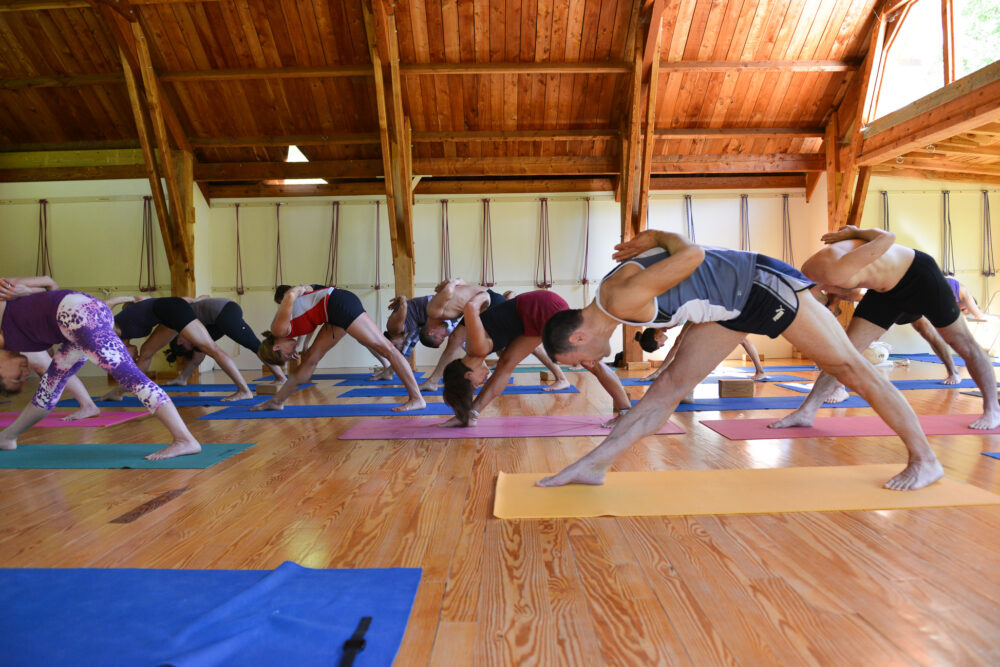Why is Iyengar Yoga Ideal for Beginners

Find out why Iyengar yoga is suitable for you wherever you are on your yoga journey – even if you have never practised yoga before
If you’re reading this post and have never done yoga before, maybe you’re wondering how to get started and which style to choose. With so many classes on offer it can be hard to work out which one is right for you. You may be aware already of the incredible physical and mental benefits of yoga. If not, you’ve got that pleasure to come. Either way, a well-trained, empathetic teacher can make all the difference.
What is Iyengar Yoga?
Iyengar yoga is known for its precision and alignment of the postures, sequencing of the postures, for the length of time the postures are held for maximum benefit and for the use of props where they are needed.
Iyengar yoga is a powerful and sophisticated discipline that can be practised at all stages of life. The benefits are far-reaching and can help those who practise it in every aspect of their daily lives. Many people enjoy the thorough, detailed teaching approach which emphasises correct alignment, making it a safe and accessible method for all body types.
If this sounds what you are looking for then finding an Iyengar teacher is an excellent way to set you on the right path to start your yoga journey.
What else is different about Iyengar yoga and why is it so good for beginners?
Iyengar yoga is different from most other methods because there is a worldwide system of teacher training and teaching. It is one of the most widely-performed methods of yoga.
Teachers are highly trained and fully insured. All Iyengar teachers continue their professional development throughout their teaching career.
Through their extensive training the teachers have an in depth knowledge of the human anatomy which enables them to help students who have injuries to practice safely.
What’s the teaching like?
Teaching is methodical and progressive – teachers help you achieve gradual, steady progress.
Teachers are trained to provide clear demonstrations of each posture in the class.
Props are available and encouraged where beneficial. They not only maximise the opening and awareness of the body but also provide support to new students, the less flexible and those with injuries.
Wherever you go in the world the teaching will be similar and you’ll know that you’re in good hands and that the teacher has been trained to a high standard. A quick internet search will help you find a qualified Iyengar teacher in many parts of the world. Although each teacher chooses postures (or asanas in Sanskrit) for a specific reason, the style of teaching will be the same as you have experienced at home.
As a beginner, what can I expect of an Iyengar yoga class?
A friendly welcome from a teacher who is passionate about what they are teaching.
Interest in you and what you want to achieve.
Information about which postures should be avoided at certain times and for certain people. For example, closed twists and inversions (head stand, shoulder stand, hand stand) should be avoided during menstruation.
No pressure to try postures that you don’t feel confident about.
Props like bricks, belts, bolsters, blankets and chairs to help you get the maximum benefit from each posture and to try the ones you thought you couldn’t do.
Where practical, Iyengar teachers move around the room at various points throughout the class to check that every student is clear about what they are expected to do, is safe and is given the appropriate adjustments for their level. This is where the props we use come into their own. Props also help you to get into good habits while you are learning without injuring yourself.
Although this may seem a long way off when you are a beginner, through skilled instruction and practice, students learn to penetrate beyond the physical body to the inner kosas (layers) of mind, energy and spirit, gaining vitality, clarity and calm.
What will we do in the Iyengar yoga class?
In general, the class will start with a few moments of quiet to prepare for the yoga.
This is followed by some preliminary postures to mobilise, open and activate the body and to quieten the brain to encourage a focused, concentrated state of mind.
Standing postures are then often practised where we learn how to adjust and align the body correctly.
The class might then focus on a particular theme such as back bends, more standing postures, forward bends, inversions such as headstand, handstand or shoulder stand.
Inversions like headstand and shoulder stand are usually for those who are ready, and, as with other poses, these can be modified for comfort and ability.
The class will end with recuperative and re-energising postures.
You’re likely to work on each pose for a while, repeating and working in detail on the subtle actions involved. As we said, your teacher will check that you’re working in the correct way and will make adjustments as necessary, sometimes using props.
Most practitioners find that focussing on opening up the body and discovering the correct action in a pose is very uplifting, bringing a feeling of freedom to the body and mind.
So, if you are interested in exploring the wonderful world of yoga and ready for all the positive benefits it offers, Iyengar yoga and its highly trained teachers will give you a warm and supportive environment in which to flourish.
[……]
